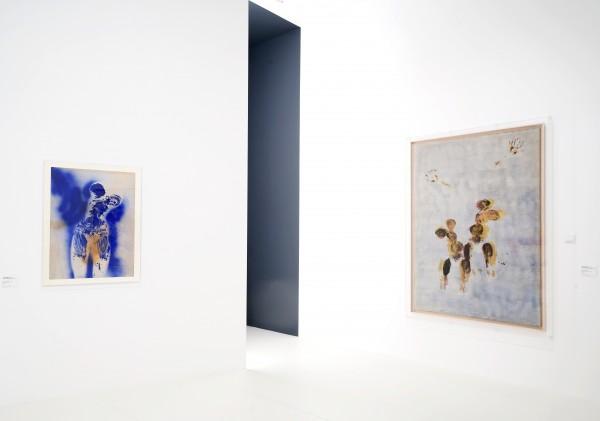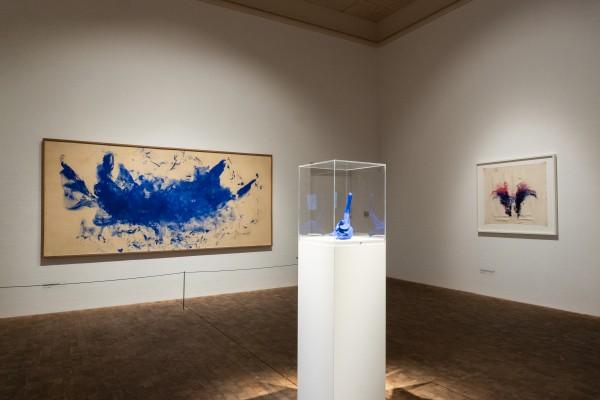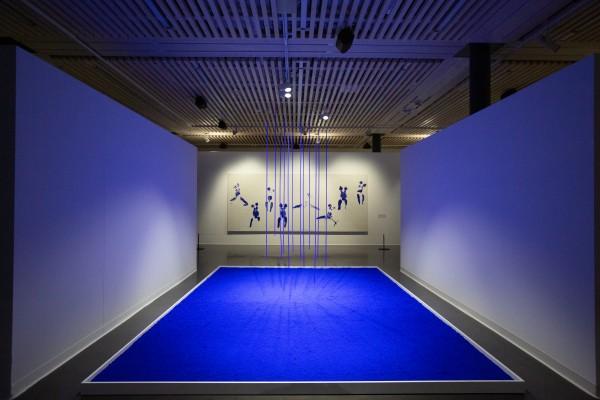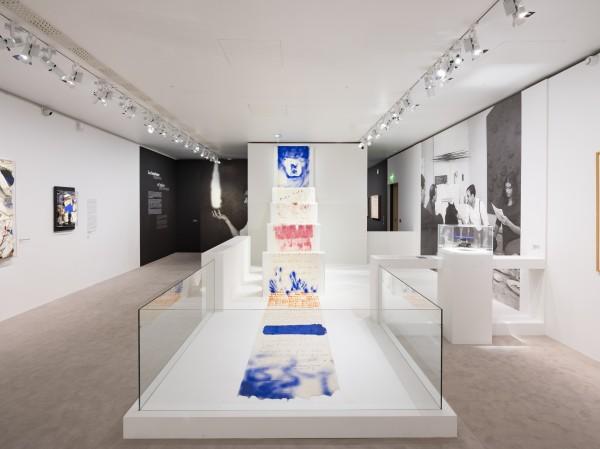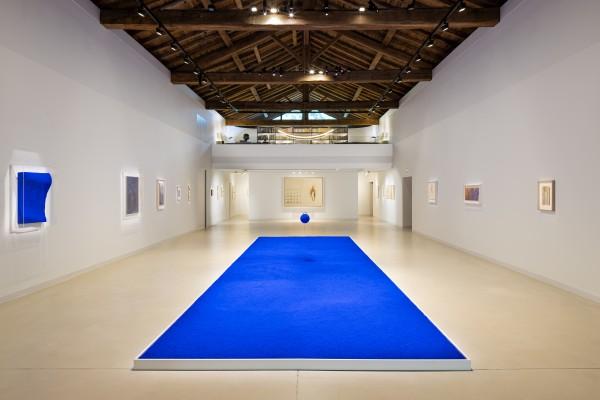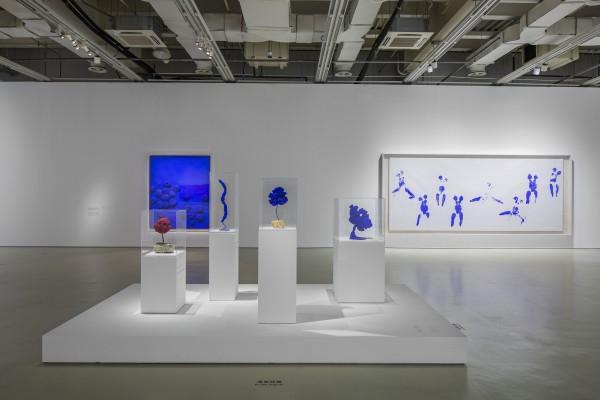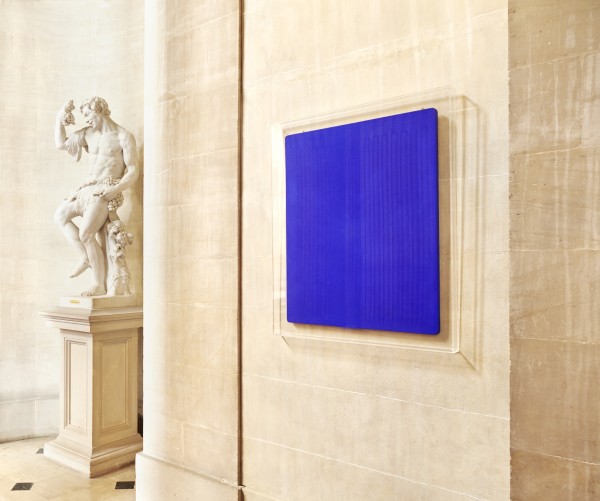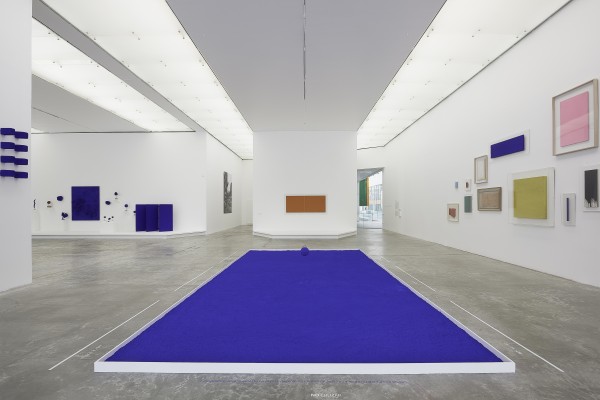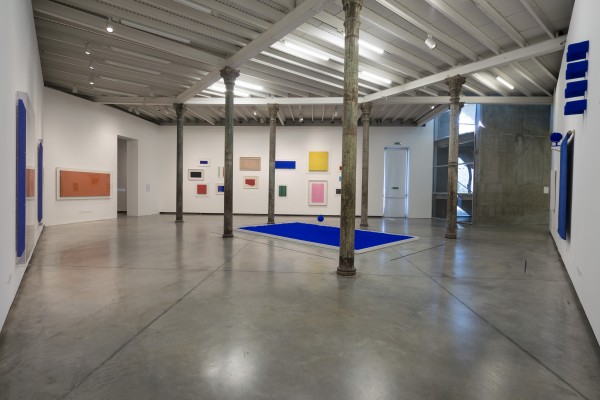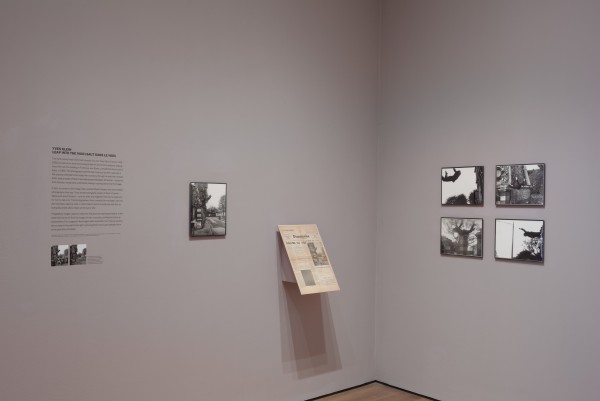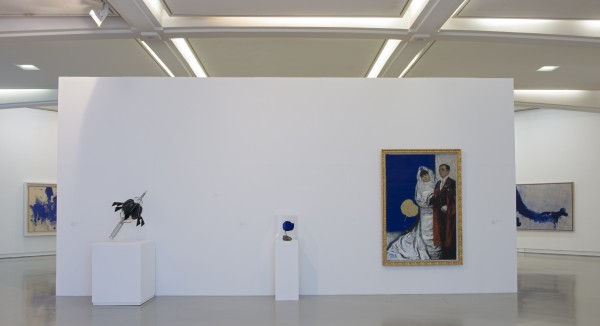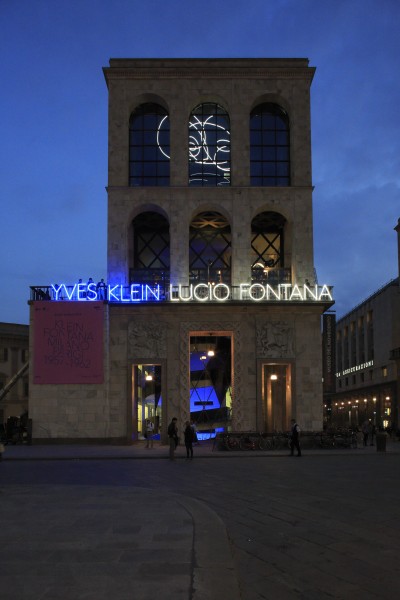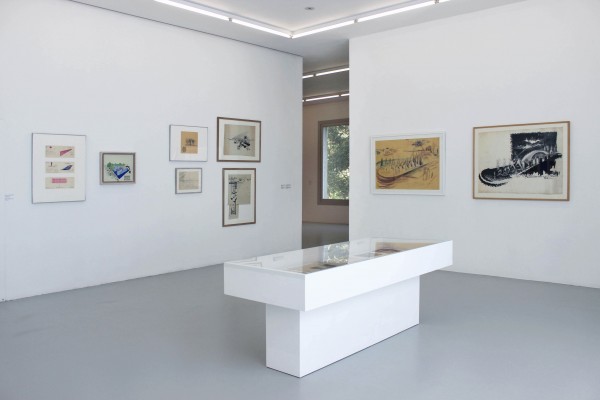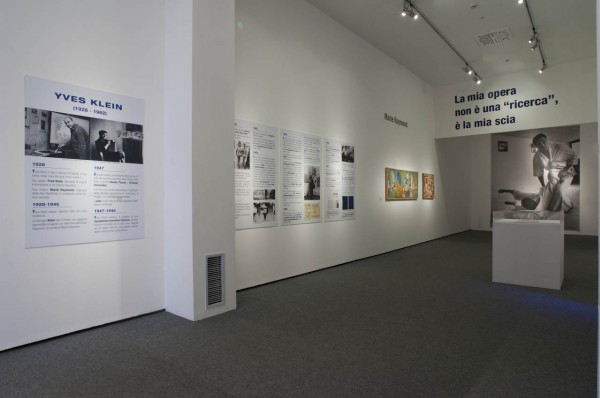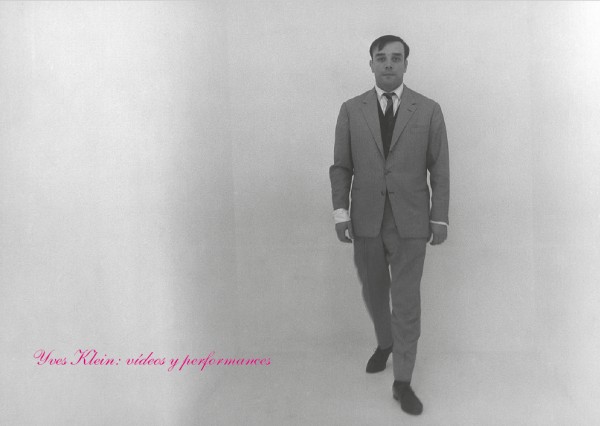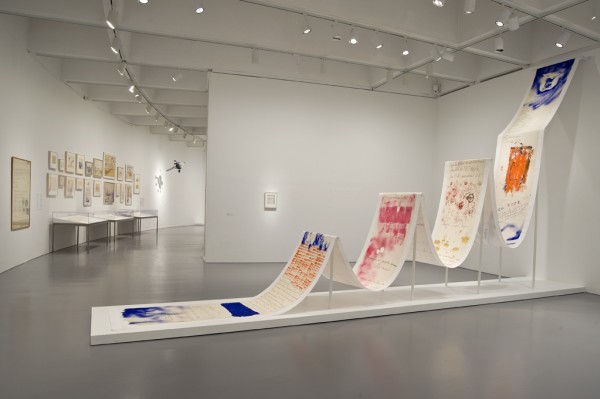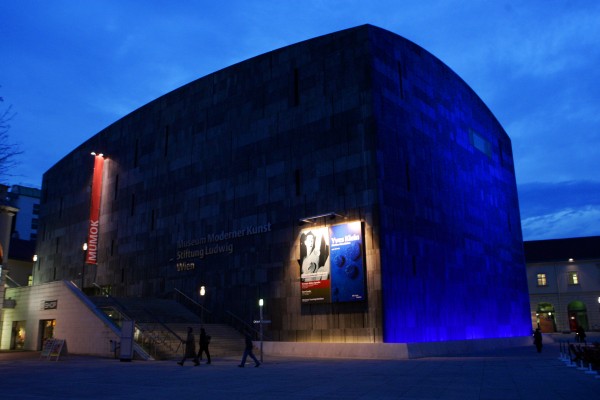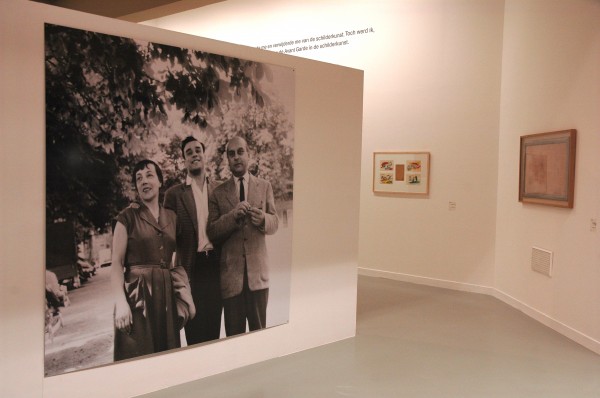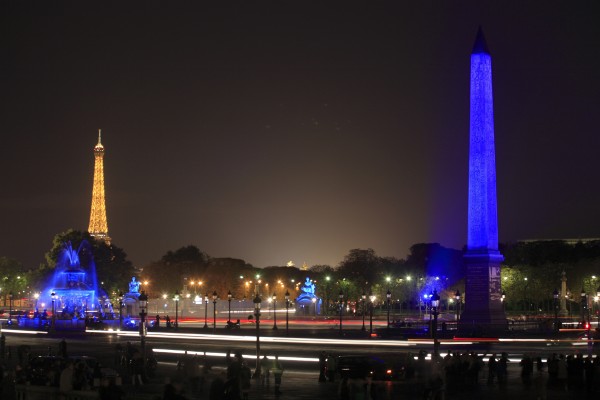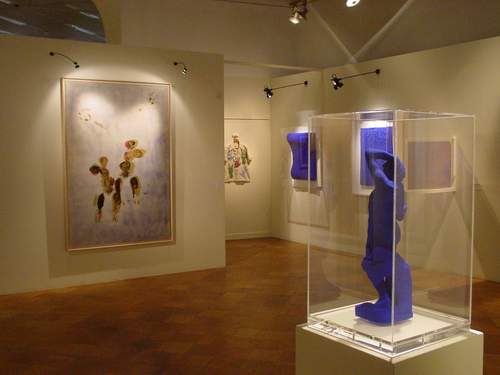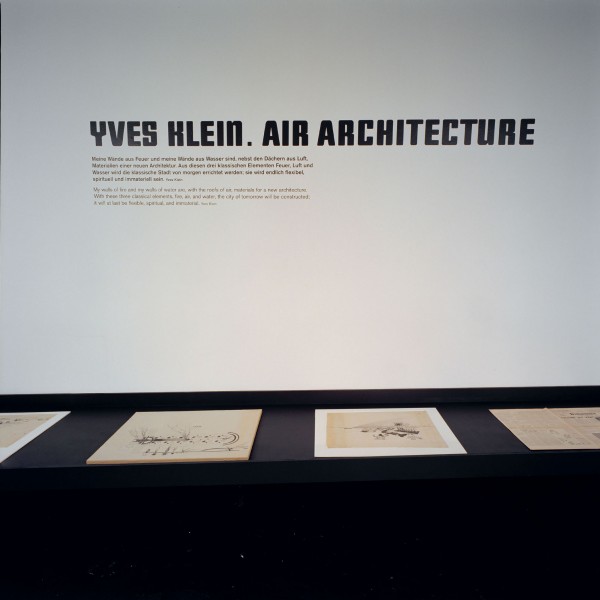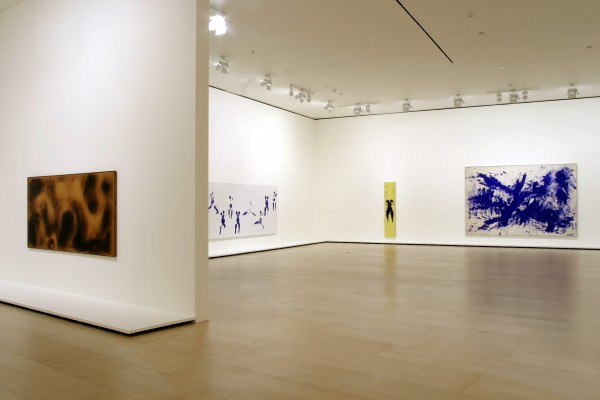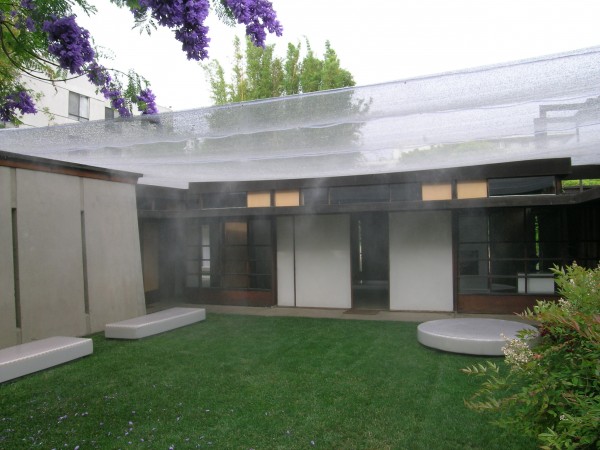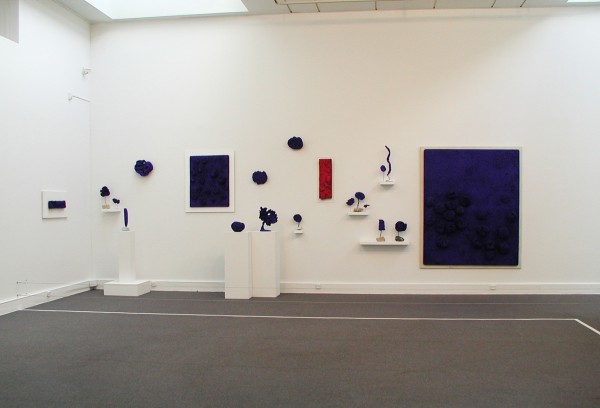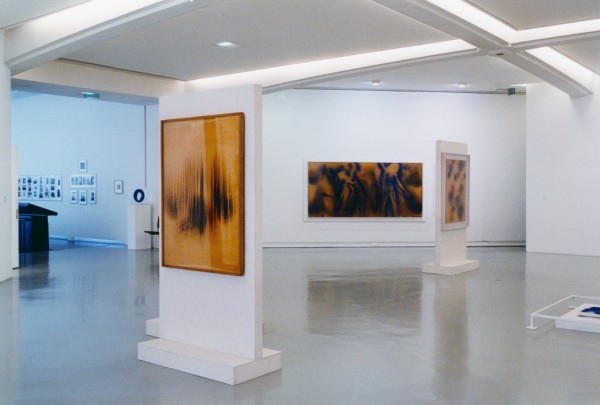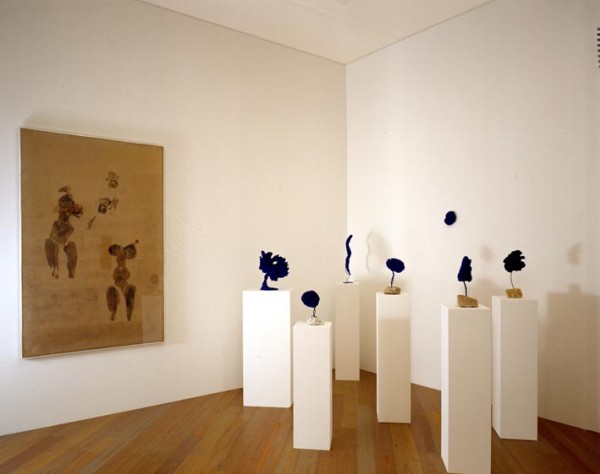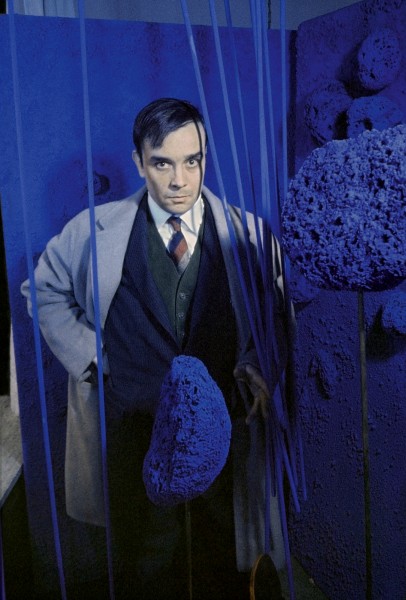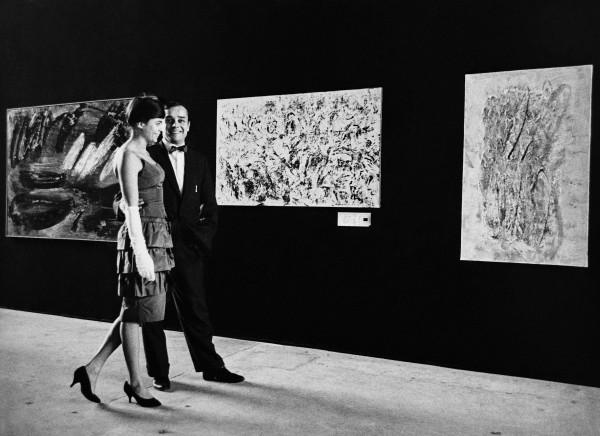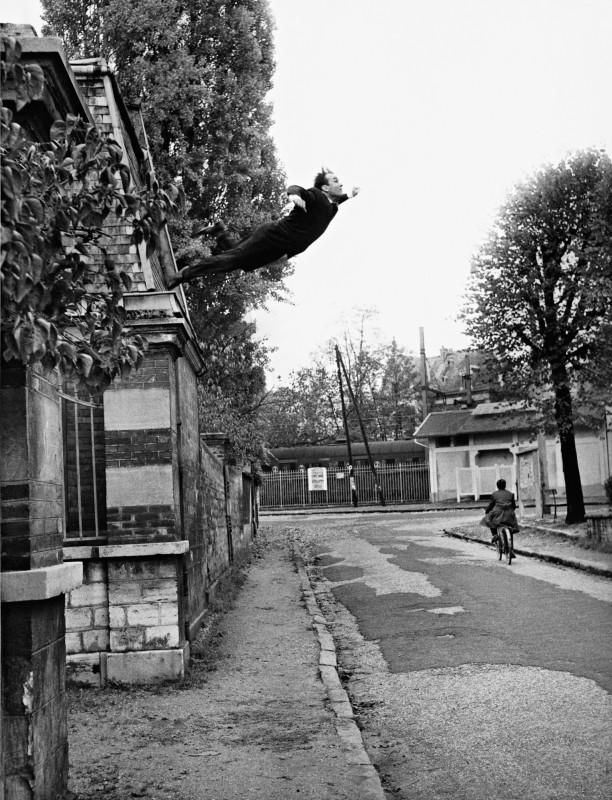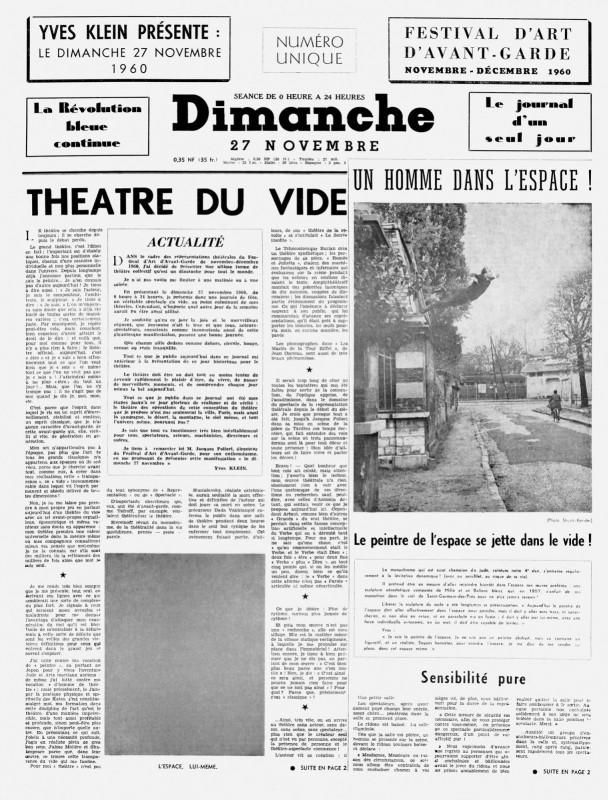Selections from "Sunday"
Yves Klein presents: Sunday, 27 November 1960
The Diary of a Single Day
The Blue Revolution Continues
News
As part of the theatrical presentations of the Festival of Avant- garde Art in November-December 1960, I have decided to present the ultimate form of collective theater: a Sunday for everybody. I did not wish to limit myself to an afternoon or evening performance.
On Sunday, 27 November 1960, from midnight to midnight, I thus present a full day of festival, a true spectacle of the Void, as a culminating point of my theories. However, any other day of the week could have been used.
I wish that on this day joy and wonder will reign., that no one will get stage fright, and that everyone, conscious as well as unconscious actors-spectators of this gigantesque presentation, should have a good day.
That everyone will come and go, move about, or remain still. Everything I write in this diary today precedes the presentation of this historic day for the theater.
The theater should be or at least rapidly attempt to become the pleasure of being, of living, of spending wondrous moments, and with each passing day of better understanding the beauty of each moment.
Everything I write in this dairy represents my own steps toward this glorious day of realism and truth: the field of opera- tions of my proposed conception of theater is not only the city, Paris, but also the countryside, the desert, the mountains, even the sky, and even the entire universe. Why not?
I know that everything inevitably is going to work out very well for everyone, spectators, actors, stagehands, directors, et. al..
I would like to thank Mr. Jacques Polieri, the director of the Avant-garde Festival, for his enthusiasm and for proposing to me that I present this “Sunday, November 27.”
Yves KLEIN
The Theater of the Void
The theater is forever searching; it searches for its lost beginnings.
The great theater is, in fact, Eden; the important thing is to establish once for good our static positions individually within the universe. For a long time already I have been announcing everywhere that I am the painter ... I know no others today! I make point of also saying: I am the actor, I am the composer, the architect, the sculptor. I make a point of saying: I am. One will no doubt object that this has already been howled out in all sort of ways; this is certainly true. I am perhaps repeating oth- ers, but I do so consciously, well aware of having earned the right to say it: and there it is, for me just as for everyone, there is nothing more to do; today the official theater is to be and I am so truly all that anyone wishes me to be and even all that one does not wish me to be! I shall even attain no longer at all to be one day! ... But, one should not be mistaken about this: it is not a matter of me when I say I, me, my, etc.
This is because the spirit in which I live is a spirit of wonder, stabilized and continuous, a classical spirit, because I have no avant-garde traits, no traits of that avant-garde which ages so quickly, from generation to generation.
My art will not belong to one age, no more so than the art of all the great classics ever belonged to the ages in which they lived, because, like them, I seek, above all, to realize in my own creations that transparence, that immeasurable void in which lives the permanent and absolute spirit freed of all dimensions! No, I do not let myself be beaten at my own game in speaking today of a theater of the Void with such a vainglorious and egocentric foreword: my theater will even assume a universal value insofar as my companions will know my thinking better than I know it myself, for if they number in the thousands they will reflect on it thousands of times more than I alone.
I am well aware that I may present myself by writing these lines on my own with what seems to be a kind of superiority complex. I point out to those who would be blind and clumsy enough to give me the advantage of attacking my exasperation with myself that it would be quite easy to lead me to defeat, but a defeat that would be on the eve of great and definitive triumphs for those who engage in the great game and know to ex- pose themselves.
I have fought against being regarded as a painter in leaving for Japan to live the adventure of Judo and the ancient martial arts there. In the same way I fought against being regarded as a man of the theater; but it was Judo, the physical and spiritual practice of the katas, that accounts, in spite of myself and unexpectedly, for my formation in that artistic discipline we call theater. All of it is just as beneficial and profound as any other, if not more so. In presenting what follows, I comply with a profound necessity, and I am acting as a realist, full of common sense. I love Molière and Shakespeare because one can find in their works this transparence of the void that so fascinates me.
For me theater is not at all a synonym for Representation or Spectacle.
Important intellectuals, themselves members of the avant- garde, like Tairov for example, wanted to even theatricalize
the theater.
Evreinoff dreamt of the monodrama, of the theatricality in
daily life, thought-gesture-speech.
Stanislavski, an extreme realist, would have liked the effec-
tive and definitive death of any actor who had to play his death on the stage. A precursor of Dada, Vakhtangov,6 locked up the public in an auditorium for two hours with no other goal than to lock them up in a gesture of mere cynicism. This event was part of his theater of revolt and titled The Strange Evening.
The Czech Burian created a synthetic theater; the characters of his play, Romeo and Juliet, were fantastic infernal machines that performed on stage while the actors read the texts off -stage. Amfitheatrof showed laconic mini-dramas of ten minutes duration, interrupted by discussions that were evidently part of the program. He would announce to his public, which commis- sioned his presentations from him in advance, that he was ready to endure tomatoes and rotten eggs, but not cobblestones.
The phonographs in Jean Cocteau’s play The Eiffel Tower Wed- ding Party are also fine examples.
It takes too long to cite here all the attempts that have been made since the beginning of the century to leave the conven- tional, learned, academic for the realm of the spectacle. I believe that almost everything has been done, right up to Jacques Polieri in his recent production of Tardieu’s play,8 in which off-stage voices and three screen-panels are the only scenery and the only presence! (His idea is moreover to bring the stage sets to life and make them speak.)
Bravo! – How fortunate that all this exists, but careful! I must warn the reader that my theatrical work has nothing, absolutely nothing to do whatsoever with any of these ex- perimentations and researches, perhaps with the exception of those by Antonin Artaud, who sensed the coming of what I am here proposing today. Artaud, however, like a good many other great minds of the true theater, loses himself in the false, artificial, and intellectual conception of the word that has rerouted so many for so long. For my part, I know that in the beginning was the word, and the word was God; two times was for two times word plus God – in all five words which, if one reflects upon them a little, clearly say what they wish to express: that Word, in this non-form, is neither articulated nor even disarticulated Speech.
What I wish for: no more rhythm, above all, never again rhythm!
And further, my work is not research; it is my slipstream, my wake. It is the very matter of the static vertiginous speed, which propels me, standing still, into the immaterial! Again, listen, I am reiterating that which I am not saying, when speaking of my work: It is clearly more beautiful because it is useless! No, I say: It is like this, and like this it will be, and no one will ever be able to make it into something else! Why? Precisely because it is classical! ...
Thus, very quickly, one arrives from this at a theater without actors, without sets, without stage, without spectators ... nothing more than the creator himself who is seen by no one, and the theater-spectacle begins!
The author lives his creation: he is his own public, and his own triumph or disaster. Rapidly, even the author himself is no longer there, and nevertheless everything continues...
To live a perpetual manifestation, to experience the permanence of being: to be present everywhere, elsewhere, inside like outside, a kind of sublimation of desire, a matter imbibed, impregnated with everywhere ... and everything continues, monotheater, beyond the psychological domain at last ...
The future of the theater is an empty hall: it is no longer a hall at all!
This 1954 manifesto has since inspired mediatory proposi- tions such as those which follow:
To create a kind of private theater to be (effectively) frequent- ed by subscription.
Each members is to receive, in exchange for their subscription, a seat in their name in the empty auditorium of the theater where a continual performance without actors, spectators, etc. is given. This constant non-representation, in this auditorium, which no one enters after the initial installation must have moments more intense than others, communicated, at the beginning, to subscribers by a program that they receive by mail or ... otherwise! On these special moments, preferably in the evening, or early morning, at the rising of the sun, the interior of the theater should be brilliantly illuminated in such manner that it can be seen well from the outside (the ideal location of such a theater, for the moment, would be Paris, the theater of Marigny, for example).
I repeat, the theater will be closed; no one can be able to go inside, only the ticket office at the entrance will be open, so that late arrivals will be able to, at the last moment, subscribe before each performance. The director of such a theater ought to search the city, the countryside, or during long trips undertaken for that purposes, for suitable actors and thus constantly renew the theater troupe. The actors will be chosen by him in the streets, everywhere, and have to be given immediately a signed contract and an advance on their fee.
The new actors thus chosen will have nothing to do but to know that they are actors and to stop by to cash their vouchers after each performance or at the moment of hyperintensity indicated in the subscribers’ program.
Thereafter, as part of their new and grave responsibility, the actors will flee the theater and vanish into the crowd to visit the enormous museum of the past that the modern world of today has become!
A Man in Space!
The painter of space leaps into the void!
The monochrome man who is also champion of judo, black
belt 4th dan, practices regularly dynamic levitation! (with or without a net, at the risk of his life).
He claims to be able to join up with his preferred work in space soon: an aerostatic sculpture, composed of one thousand and one blue balloons, which will take off from his exhibition in 1957 into the sky of Saint-Germain-des-Prés never again
to return!
To liberate sculpture from its pedestal has long been his concern. Today the painter of space must, in fact, go into space to paint, but he must go there without trickery or deception, and not in an air- plane, nor by parachute or in a rocket: he must go there on his own strength, using an autonomous individual force; in short, he must be capable of levitation.
Yves: I am the painter of space. I am not an abstract painter but, on the contrary, a figurative artist, and a realist. Let us be honest, to paint space, I must be in position, I must be in space.
Pure sensibility
A small auditorium.
The spectators, after having duly paid their rather pricey admission fee, enter the auditorium, and take their seats.
The curtain is lowered. The auditorium illuminated.
When the auditorium is filled, a man gets on stage, in front of the still lowered curtain, and announces:
Ladies and Gentlemen, due to circumstances, this evening we are forced to chain you to your seats (and, in addition, to gag you) for the duration of the presentation. This measure of security is necessary in order to protect you from yourselves in the presence of this particularly dangerous performance, from a purely emotional point of view!
We express in advance our regrets to those of you who are not unable to be chained and gagged before the raising of the curtain and we kindly ask that you leave the auditorium and request a refund at the exit. No one will be permitted to stay in the auditorium unless firmly chained to their seats during the performance. Thank you.
... At once a group of chainers and gaggers enter the auditorium and systematically and rapidly, row after row, paralyze all the spectators.
When it is done ... the room darkens ... the curtain rises ac- companied by a continuous fizzing sound, similar to that made by freshly opened carbonated water, but prodigiously amplified. It is an acoustic, monotonous inundation, impregnating space in a volumetric way, perceptible to the sensitive hearing of each spectator.
The stage is a white empty space, very white, with curved corners ... Everything is empty, absolutely empty with fizz! (If the spectators were not gagged, the acoustics would need to be to cutoff).
Beautiful young girls, nude or, at most, wearing bikinis, mingle like hostesses with the male spectators in the auditorium and comfort them, adjusting their chains and gags, telling them the time and how much longer they have to endure the spec- tacle (extremely handsome young men, also nude or, at most, wearing bikinis, attend to the female spectators).
After the first half hour, the fizzing sound fades away, little by little, until it is completely dissolved. Another half hour passes in absolute silence, during which the spectators continue to face the empty, white, and brilliantly illuminated stage.
The curtain lowers. The light return in the auditorium. The groups of chainers return to free the spectators from their chains and gags.
Capture of the Void
An entire city, indeed even a capital or, better yet, an entire country will serve as stage and scenery. The State itself will announces the date of the presentation throughout the land. On the designated day, at the designated hour, everyone will return home, lock the door with two turns of the key, and the outside world will be devoid of humans for two hours.
There is no one In the streets, no one in any of the administra- tive offices and other public places, no one in the countryside; everything is closed; everyone is at home and no one moves. The land will appear in the eyes of Space, for two hours, entirely devoid of living subjects!
... Then my faithful associates who are with me will throw me out of my home against my will, for I shall be afraid and it will be necessary that I should be literally expelled outside, into the emptiness of the streets and the countryside, facing nature and everything else alone. To speak frankly, this will be but one step on the road to the capture of the real void, which will be accom- plished after my definitive disappearance, during of one of these solemn national seances. This capture of the void will be realized by those who will have understood its concept or, rather, its principle and who will experience it, at last, as pure and static action in a completely natural manner.
Come With Me Into the Void
I have been painting already for several years most often from models and even with the effective collaboration of models. Indeed, for a long time I have wondered why figurative paint- ers or even sometimes abstract painters such as Fautrier, for example, feel the need to paint nudes. To simply seek out a living human form to draw and to copy after nature was not good enough a reason for me; I felt that there must be something else. The nude model brings sensuality into the atmosphere. Careful: not sexuality!
Models create a sensual climate inside the studio, just as they do possibly outside, which permits the stabilization of the pic- torial matter. In the true sense of the Christian faith, which says: I believe in the incarnation of the word; I believe in the resurrection of the body, the body is the true sense of the theater of the word: the word is flesh!
And so I engaged models and I tried it; it was very beauti- ful. I was fascinated by the flesh, the delicacy of living skin, its extraordinary color and, paradoxically, at the same time, its colorlessness.
My models laughed at me as they watched me execute, with themselves as subjects, splendid and uniformly blue monochromes! They laughed but, more and more, felt themselves drawn to the blue.
One day, I understood that my hands, the tools by which I manipulated color, were no longer sufficient. I needed to paint monochrome canvases with the models themselves ... No, this was no erotic folly!
It was even more beautiful. I threw a large white canvas on the ground. I poured some twenty kilos of blue paint in the middle of it and the model literally jumped into it. She painted the painting by rolling her body over the surface of the canvas in every direction.
I directed the operation standing up, moving quickly around the entire perimeter of that fantastic surface on the ground, guiding the model’s every movement, and repositioning her. The young woman, so inebriated by the action and by the close contact of her flesh with the blue, ended up no longer hearing me shouting at her: “Again a little more to the right, there, come back by rolling on that side, the other corner is not yet covered, come over here and apply your right breast, etc.”
There was never anything at all erotic or pornographic about these fantastic sessions, nothing amoral; when the painting was finished, my model took a bath. I never touched any of them; it is for this reason that they trust me and that they love to collaborate with their entire bodies on my painting. It was the solution to the problem of distance in painting: my living brushes were commanded by remote control.
With me, they understood; they were doing something; they were acting. Before, with the figurative artists who sketched them, they recognized themselves afterwards in the paint- ings. Then came the abstract artists and it became disquieting, psychological, and unhealthy. They, in fact, no longer under- stood what purpose they were serving.
With me, they first thought that I was insane; but soon they would not pass up any chance to come and pose for me or rather to come and work with me!
This is what I wish to present on the stage accompanied by, as musical background, the song Come With Me Into the Void, with music by Hans-Martin Majewski:
When I think of you
The same dream always returns
We are walking arm in arm
On the wild path of our holidays
When, little by little,
Everything seems to disappear around us The trees, the flowers, the sea
Along the sides of the path
Suddenly there is no longer anything
We are at our end of the world
Well ... Should we turn back?
No ... you say no
Come with me into the Void!
If you return one day
You who also dreams
Of this marvelous void
Of this absolute love
I know that together,
Without saying a word,
We will leap
Into the reality of this void
Which awaits our love
As I wait for you every day:
Come with me into the void!
(1957)
Conclusion
... If evil there be; ... I did not wish for it!
See The Naturometry of the Blue Period 10 for the pictorial development of that proposition.
Monochrome Stupefaction
The convened spectators enter an empty room whose floor is covered with rich, white, wooly carpet. There they receive blue pills to be consumed on the spot.
Within two or three minutes later, they collapse under the effect of the drug: that is to say, they fall into an agreeable dynamic torpor in which an immense interior space appears, like the blue of the sky, a uniform monochrome blue.
(Even so, within this blue, two other colors seem quite dis- tinct and separate from each other: gold and pink, but in the final analysis everything is a uniform I.K.B. blue.)
It is the beatitude of artificial paradises in blue. Everyone indulges in it.
Yves Klein presents: Sunday, 27 November 1960
The Diary of a Single Day
The Blue Revolution Continues
News
As part of the theatrical presentations of the Festival of Avant- garde Art in November-December 1960, I have decided to present the ultimate form of collective theater: a Sunday for everybody. I did not wish to limit myself to an afternoon or evening performance.
On Sunday, 27 November 1960, from midnight to midnight, I thus present a full day of festival, a true spectacle of the Void, as a culminating point of my theories. However, any other day of the week could have been used.
I wish that on this day joy and wonder will reign., that no one will get stage fright, and that everyone, conscious as well as unconscious actors-spectators of this gigantesque presentation, should have a good day.
That everyone will come and go, move about, or remain still. Everything I write in this diary today precedes the presentation of this historic day for the theater.
The theater should be or at least rapidly attempt to become the pleasure of being, of living, of spending wondrous moments, and with each passing day of better understanding the beauty of each moment.
Everything I write in this dairy represents my own steps toward this glorious day of realism and truth: the field of opera- tions of my proposed conception of theater is not only the city, Paris, but also the countryside, the desert, the mountains, even the sky, and even the entire universe. Why not?
I know that everything inevitably is going to work out very well for everyone, spectators, actors, stagehands, directors, et. al..
I would like to thank Mr. Jacques Polieri, the director of the Avant-garde Festival, for his enthusiasm and for proposing to me that I present this “Sunday, November 27.”
Yves KLEIN
The Theater of the Void
The theater is forever searching; it searches for its lost beginnings.
The great theater is, in fact, Eden; the important thing is to establish once for good our static positions individually within the universe. For a long time already I have been announcing everywhere that I am the painter ... I know no others today! I make point of also saying: I am the actor, I am the composer, the architect, the sculptor. I make a point of saying: I am. One will no doubt object that this has already been howled out in all sort of ways; this is certainly true. I am perhaps repeating oth- ers, but I do so consciously, well aware of having earned the right to say it: and there it is, for me just as for everyone, there is nothing more to do; today the official theater is to be and I am so truly all that anyone wishes me to be and even all that one does not wish me to be! I shall even attain no longer at all to be one day! ... But, one should not be mistaken about this: it is not a matter of me when I say I, me, my, etc.
This is because the spirit in which I live is a spirit of wonder, stabilized and continuous, a classical spirit, because I have no avant-garde traits, no traits of that avant-garde which ages so quickly, from generation to generation.
My art will not belong to one age, no more so than the art of all the great classics ever belonged to the ages in which they lived, because, like them, I seek, above all, to realize in my own creations that transparence, that immeasurable void in which lives the permanent and absolute spirit freed of all dimensions! No, I do not let myself be beaten at my own game in speaking today of a theater of the Void with such a vainglorious and egocentric foreword: my theater will even assume a universal value insofar as my companions will know my thinking better than I know it myself, for if they number in the thousands they will reflect on it thousands of times more than I alone.
I am well aware that I may present myself by writing these lines on my own with what seems to be a kind of superiority complex. I point out to those who would be blind and clumsy enough to give me the advantage of attacking my exasperation with myself that it would be quite easy to lead me to defeat, but a defeat that would be on the eve of great and definitive triumphs for those who engage in the great game and know to ex- pose themselves.
I have fought against being regarded as a painter in leaving for Japan to live the adventure of Judo and the ancient martial arts there. In the same way I fought against being regarded as a man of the theater; but it was Judo, the physical and spiritual practice of the katas, that accounts, in spite of myself and unexpectedly, for my formation in that artistic discipline we call theater. All of it is just as beneficial and profound as any other, if not more so. In presenting what follows, I comply with a profound necessity, and I am acting as a realist, full of common sense. I love Molière and Shakespeare because one can find in their works this transparence of the void that so fascinates me.
For me theater is not at all a synonym for Representation or Spectacle.
Important intellectuals, themselves members of the avant- garde, like Tairov for example, wanted to even theatricalize
the theater.
Evreinoff dreamt of the monodrama, of the theatricality in
daily life, thought-gesture-speech.
Stanislavski, an extreme realist, would have liked the effec-
tive and definitive death of any actor who had to play his death on the stage. A precursor of Dada, Vakhtangov,6 locked up the public in an auditorium for two hours with no other goal than to lock them up in a gesture of mere cynicism. This event was part of his theater of revolt and titled The Strange Evening.
The Czech Burian created a synthetic theater; the characters of his play, Romeo and Juliet, were fantastic infernal machines that performed on stage while the actors read the texts off -stage. Amfitheatrof showed laconic mini-dramas of ten minutes duration, interrupted by discussions that were evidently part of the program. He would announce to his public, which commis- sioned his presentations from him in advance, that he was ready to endure tomatoes and rotten eggs, but not cobblestones.
The phonographs in Jean Cocteau’s play The Eiffel Tower Wed- ding Party are also fine examples.
It takes too long to cite here all the attempts that have been made since the beginning of the century to leave the conven- tional, learned, academic for the realm of the spectacle. I believe that almost everything has been done, right up to Jacques Polieri in his recent production of Tardieu’s play,8 in which off-stage voices and three screen-panels are the only scenery and the only presence! (His idea is moreover to bring the stage sets to life and make them speak.)
Bravo! – How fortunate that all this exists, but careful! I must warn the reader that my theatrical work has nothing, absolutely nothing to do whatsoever with any of these ex- perimentations and researches, perhaps with the exception of those by Antonin Artaud, who sensed the coming of what I am here proposing today. Artaud, however, like a good many other great minds of the true theater, loses himself in the false, artificial, and intellectual conception of the word that has rerouted so many for so long. For my part, I know that in the beginning was the word, and the word was God; two times was for two times word plus God – in all five words which, if one reflects upon them a little, clearly say what they wish to express: that Word, in this non-form, is neither articulated nor even disarticulated Speech.
What I wish for: no more rhythm, above all, never again rhythm!
And further, my work is not research; it is my slipstream, my wake. It is the very matter of the static vertiginous speed, which propels me, standing still, into the immaterial! Again, listen, I am reiterating that which I am not saying, when speaking of my work: It is clearly more beautiful because it is useless! No, I say: It is like this, and like this it will be, and no one will ever be able to make it into something else! Why? Precisely because it is classical! ...
Thus, very quickly, one arrives from this at a theater without actors, without sets, without stage, without spectators ... nothing more than the creator himself who is seen by no one, and the theater-spectacle begins!
The author lives his creation: he is his own public, and his own triumph or disaster. Rapidly, even the author himself is no longer there, and nevertheless everything continues...
To live a perpetual manifestation, to experience the permanence of being: to be present everywhere, elsewhere, inside like outside, a kind of sublimation of desire, a matter imbibed, impregnated with everywhere ... and everything continues, monotheater, beyond the psychological domain at last ...
The future of the theater is an empty hall: it is no longer a hall at all!
This 1954 manifesto has since inspired mediatory proposi- tions such as those which follow:
To create a kind of private theater to be (effectively) frequent- ed by subscription.
Each members is to receive, in exchange for their subscription, a seat in their name in the empty auditorium of the theater where a continual performance without actors, spectators, etc. is given. This constant non-representation, in this auditorium, which no one enters after the initial installation must have moments more intense than others, communicated, at the beginning, to subscribers by a program that they receive by mail or ... otherwise! On these special moments, preferably in the evening, or early morning, at the rising of the sun, the interior of the theater should be brilliantly illuminated in such manner that it can be seen well from the outside (the ideal location of such a theater, for the moment, would be Paris, the theater of Marigny, for example).
I repeat, the theater will be closed; no one can be able to go inside, only the ticket office at the entrance will be open, so that late arrivals will be able to, at the last moment, subscribe before each performance. The director of such a theater ought to search the city, the countryside, or during long trips undertaken for that purposes, for suitable actors and thus constantly renew the theater troupe. The actors will be chosen by him in the streets, everywhere, and have to be given immediately a signed contract and an advance on their fee.
The new actors thus chosen will have nothing to do but to know that they are actors and to stop by to cash their vouchers after each performance or at the moment of hyperintensity indicated in the subscribers’ program.
Thereafter, as part of their new and grave responsibility, the actors will flee the theater and vanish into the crowd to visit the enormous museum of the past that the modern world of today has become!
A Man in Space!
The painter of space leaps into the void!
The monochrome man who is also champion of judo, black
belt 4th dan, practices regularly dynamic levitation! (with or without a net, at the risk of his life).
He claims to be able to join up with his preferred work in space soon: an aerostatic sculpture, composed of one thousand and one blue balloons, which will take off from his exhibition in 1957 into the sky of Saint-Germain-des-Prés never again
to return!
To liberate sculpture from its pedestal has long been his concern. Today the painter of space must, in fact, go into space to paint, but he must go there without trickery or deception, and not in an air- plane, nor by parachute or in a rocket: he must go there on his own strength, using an autonomous individual force; in short, he must be capable of levitation.
Yves: I am the painter of space. I am not an abstract painter but, on the contrary, a figurative artist, and a realist. Let us be honest, to paint space, I must be in position, I must be in space.
Pure sensibility
A small auditorium.
The spectators, after having duly paid their rather pricey admission fee, enter the auditorium, and take their seats.
The curtain is lowered. The auditorium illuminated.
When the auditorium is filled, a man gets on stage, in front of the still lowered curtain, and announces:
Ladies and Gentlemen, due to circumstances, this evening we are forced to chain you to your seats (and, in addition, to gag you) for the duration of the presentation. This measure of security is necessary in order to protect you from yourselves in the presence of this particularly dangerous performance, from a purely emotional point of view!
We express in advance our regrets to those of you who are not unable to be chained and gagged before the raising of the curtain and we kindly ask that you leave the auditorium and request a refund at the exit. No one will be permitted to stay in the auditorium unless firmly chained to their seats during the performance. Thank you.
... At once a group of chainers and gaggers enter the auditorium and systematically and rapidly, row after row, paralyze all the spectators.
When it is done ... the room darkens ... the curtain rises ac- companied by a continuous fizzing sound, similar to that made by freshly opened carbonated water, but prodigiously amplified. It is an acoustic, monotonous inundation, impregnating space in a volumetric way, perceptible to the sensitive hearing of each spectator.
The stage is a white empty space, very white, with curved corners ... Everything is empty, absolutely empty with fizz! (If the spectators were not gagged, the acoustics would need to be to cutoff).
Beautiful young girls, nude or, at most, wearing bikinis, mingle like hostesses with the male spectators in the auditorium and comfort them, adjusting their chains and gags, telling them the time and how much longer they have to endure the spec- tacle (extremely handsome young men, also nude or, at most, wearing bikinis, attend to the female spectators).
After the first half hour, the fizzing sound fades away, little by little, until it is completely dissolved. Another half hour passes in absolute silence, during which the spectators continue to face the empty, white, and brilliantly illuminated stage.
The curtain lowers. The light return in the auditorium. The groups of chainers return to free the spectators from their chains and gags.
Capture of the Void
An entire city, indeed even a capital or, better yet, an entire country will serve as stage and scenery. The State itself will announces the date of the presentation throughout the land. On the designated day, at the designated hour, everyone will return home, lock the door with two turns of the key, and the outside world will be devoid of humans for two hours.
There is no one In the streets, no one in any of the administra- tive offices and other public places, no one in the countryside; everything is closed; everyone is at home and no one moves. The land will appear in the eyes of Space, for two hours, entirely devoid of living subjects!
... Then my faithful associates who are with me will throw me out of my home against my will, for I shall be afraid and it will be necessary that I should be literally expelled outside, into the emptiness of the streets and the countryside, facing nature and everything else alone. To speak frankly, this will be but one step on the road to the capture of the real void, which will be accom- plished after my definitive disappearance, during of one of these solemn national seances. This capture of the void will be realized by those who will have understood its concept or, rather, its principle and who will experience it, at last, as pure and static action in a completely natural manner.
Come With Me Into the Void
I have been painting already for several years most often from models and even with the effective collaboration of models. Indeed, for a long time I have wondered why figurative paint- ers or even sometimes abstract painters such as Fautrier, for example, feel the need to paint nudes. To simply seek out a living human form to draw and to copy after nature was not good enough a reason for me; I felt that there must be something else. The nude model brings sensuality into the atmosphere. Careful: not sexuality!
Models create a sensual climate inside the studio, just as they do possibly outside, which permits the stabilization of the pic- torial matter. In the true sense of the Christian faith, which says: I believe in the incarnation of the word; I believe in the resurrection of the body, the body is the true sense of the theater of the word: the word is flesh!
And so I engaged models and I tried it; it was very beauti- ful. I was fascinated by the flesh, the delicacy of living skin, its extraordinary color and, paradoxically, at the same time, its colorlessness.
My models laughed at me as they watched me execute, with themselves as subjects, splendid and uniformly blue monochromes! They laughed but, more and more, felt themselves drawn to the blue.
One day, I understood that my hands, the tools by which I manipulated color, were no longer sufficient. I needed to paint monochrome canvases with the models themselves ... No, this was no erotic folly!
It was even more beautiful. I threw a large white canvas on the ground. I poured some twenty kilos of blue paint in the middle of it and the model literally jumped into it. She painted the painting by rolling her body over the surface of the canvas in every direction.
I directed the operation standing up, moving quickly around the entire perimeter of that fantastic surface on the ground, guiding the model’s every movement, and repositioning her. The young woman, so inebriated by the action and by the close contact of her flesh with the blue, ended up no longer hearing me shouting at her: “Again a little more to the right, there, come back by rolling on that side, the other corner is not yet covered, come over here and apply your right breast, etc.”
There was never anything at all erotic or pornographic about these fantastic sessions, nothing amoral; when the painting was finished, my model took a bath. I never touched any of them; it is for this reason that they trust me and that they love to collaborate with their entire bodies on my painting. It was the solution to the problem of distance in painting: my living brushes were commanded by remote control.
With me, they understood; they were doing something; they were acting. Before, with the figurative artists who sketched them, they recognized themselves afterwards in the paint- ings. Then came the abstract artists and it became disquieting, psychological, and unhealthy. They, in fact, no longer under- stood what purpose they were serving.
With me, they first thought that I was insane; but soon they would not pass up any chance to come and pose for me or rather to come and work with me!
This is what I wish to present on the stage accompanied by, as musical background, the song Come With Me Into the Void, with music by Hans-Martin Majewski:
When I think of you
The same dream always returns
We are walking arm in arm
On the wild path of our holidays
When, little by little,
Everything seems to disappear around us The trees, the flowers, the sea
Along the sides of the path
Suddenly there is no longer anything
We are at our end of the world
Well ... Should we turn back?
No ... you say no
Come with me into the Void!
If you return one day
You who also dreams
Of this marvelous void
Of this absolute love
I know that together,
Without saying a word,
We will leap
Into the reality of this void
Which awaits our love
As I wait for you every day:
Come with me into the void!
(1957)
Conclusion
... If evil there be; ... I did not wish for it!
See The Naturometry of the Blue Period 10 for the pictorial development of that proposition.
Monochrome Stupefaction
The convened spectators enter an empty room whose floor is covered with rich, white, wooly carpet. There they receive blue pills to be consumed on the spot.
Within two or three minutes later, they collapse under the effect of the drug: that is to say, they fall into an agreeable dynamic torpor in which an immense interior space appears, like the blue of the sky, a uniform monochrome blue.
(Even so, within this blue, two other colors seem quite dis- tinct and separate from each other: gold and pink, but in the final analysis everything is a uniform I.K.B. blue.)
It is the beatitude of artificial paradises in blue. Everyone indulges in it.
| Technical | Newsprint |
| Dimensions | 55.5 x 38cm |
| Collection | Museum of Modern Art (MoMA) |
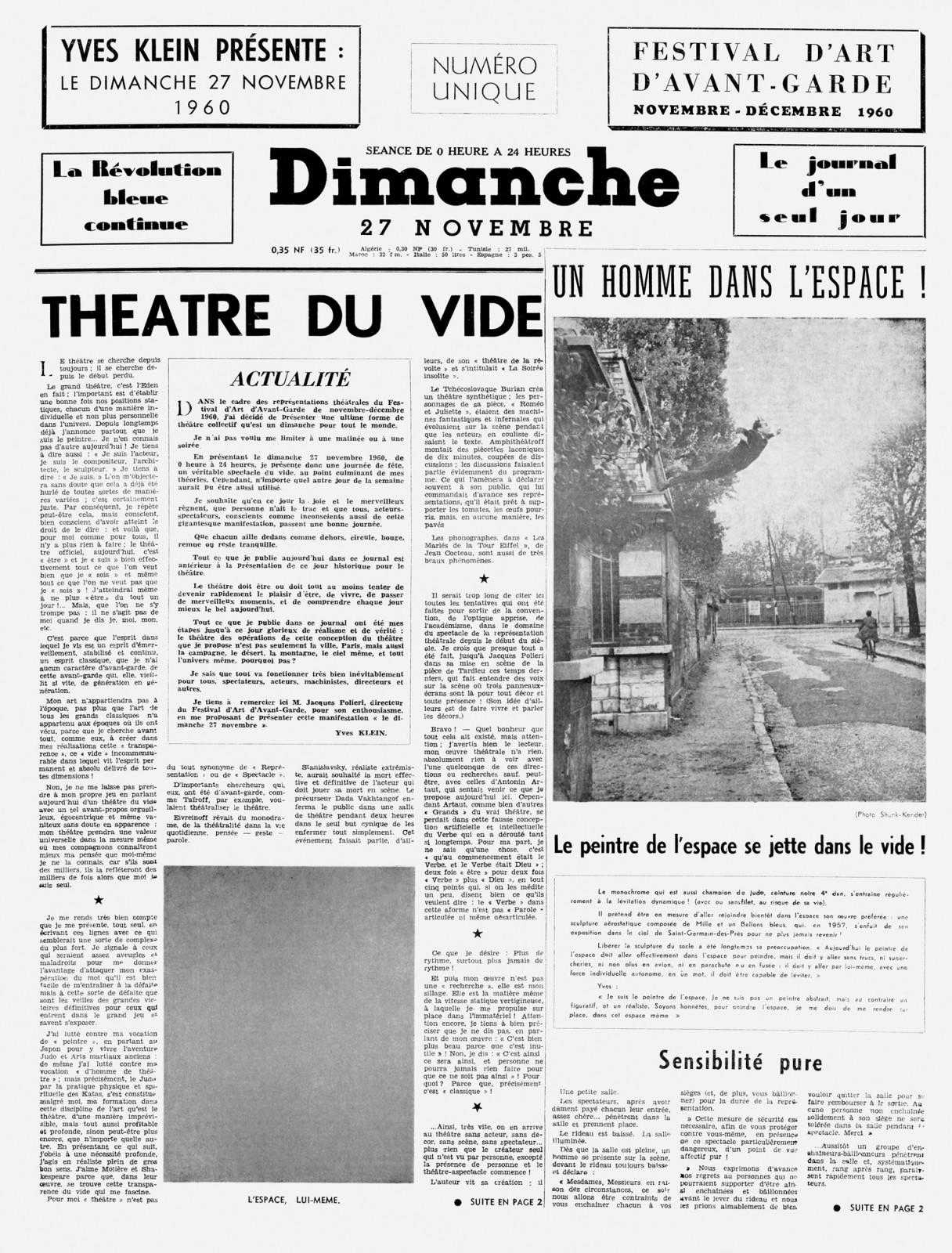
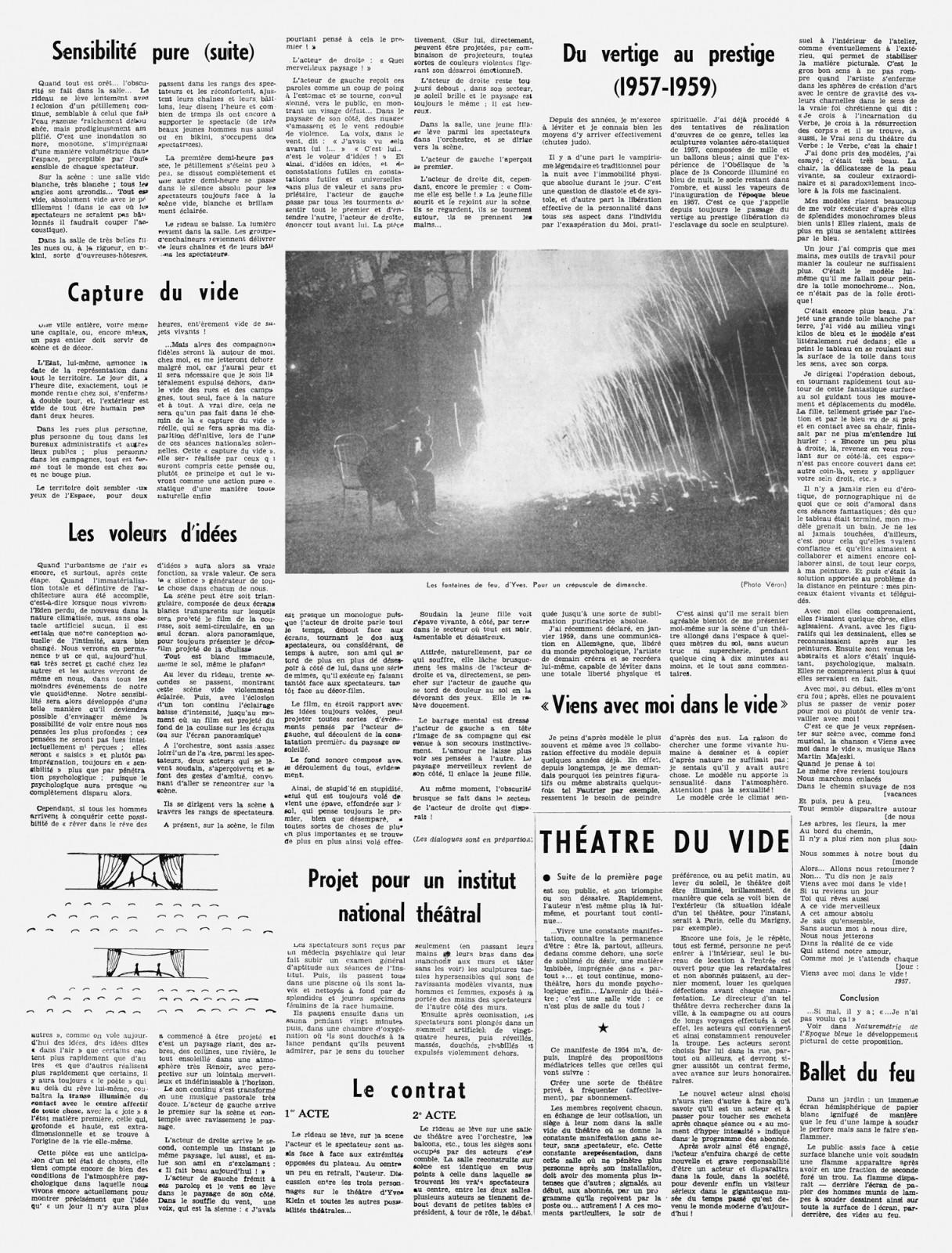
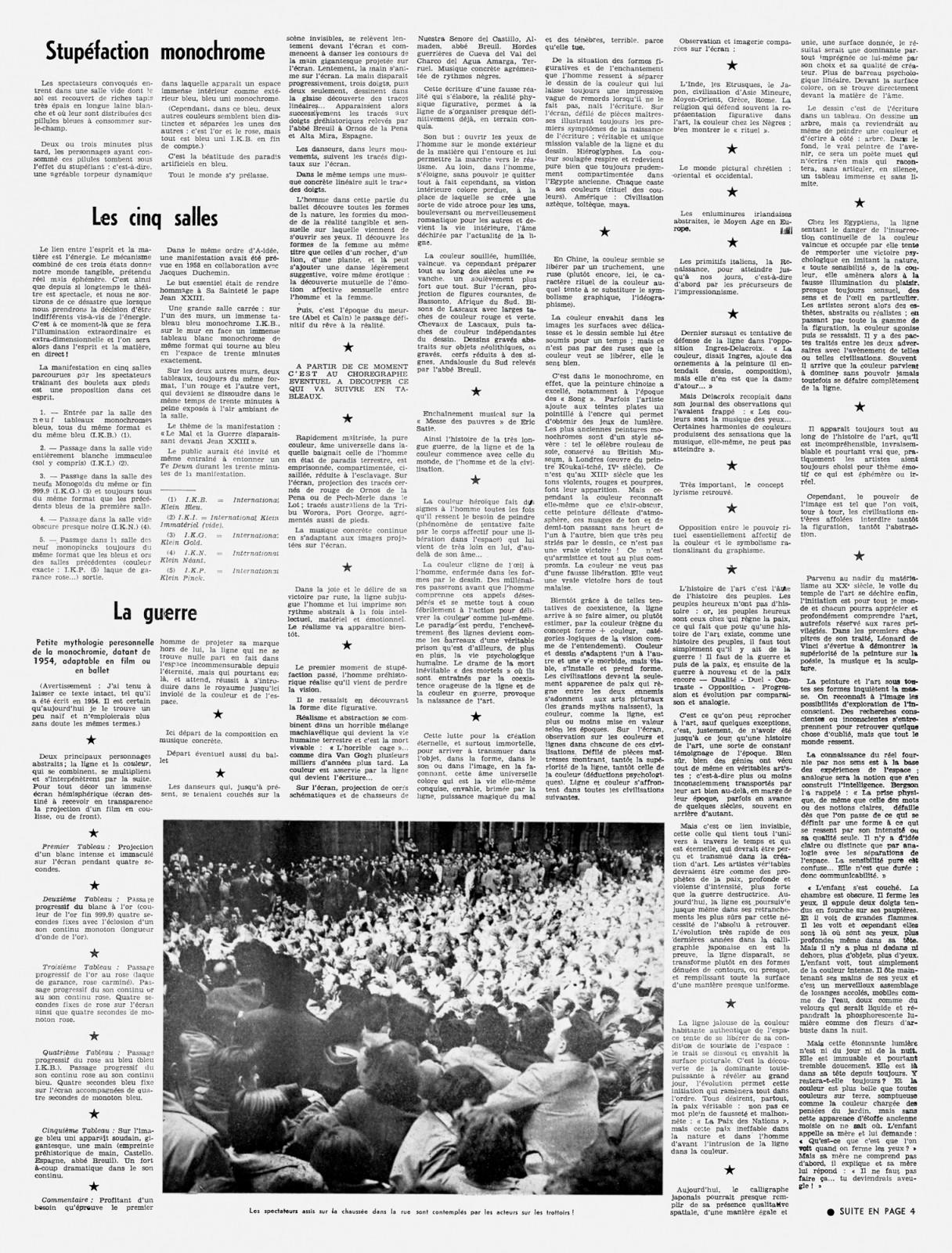
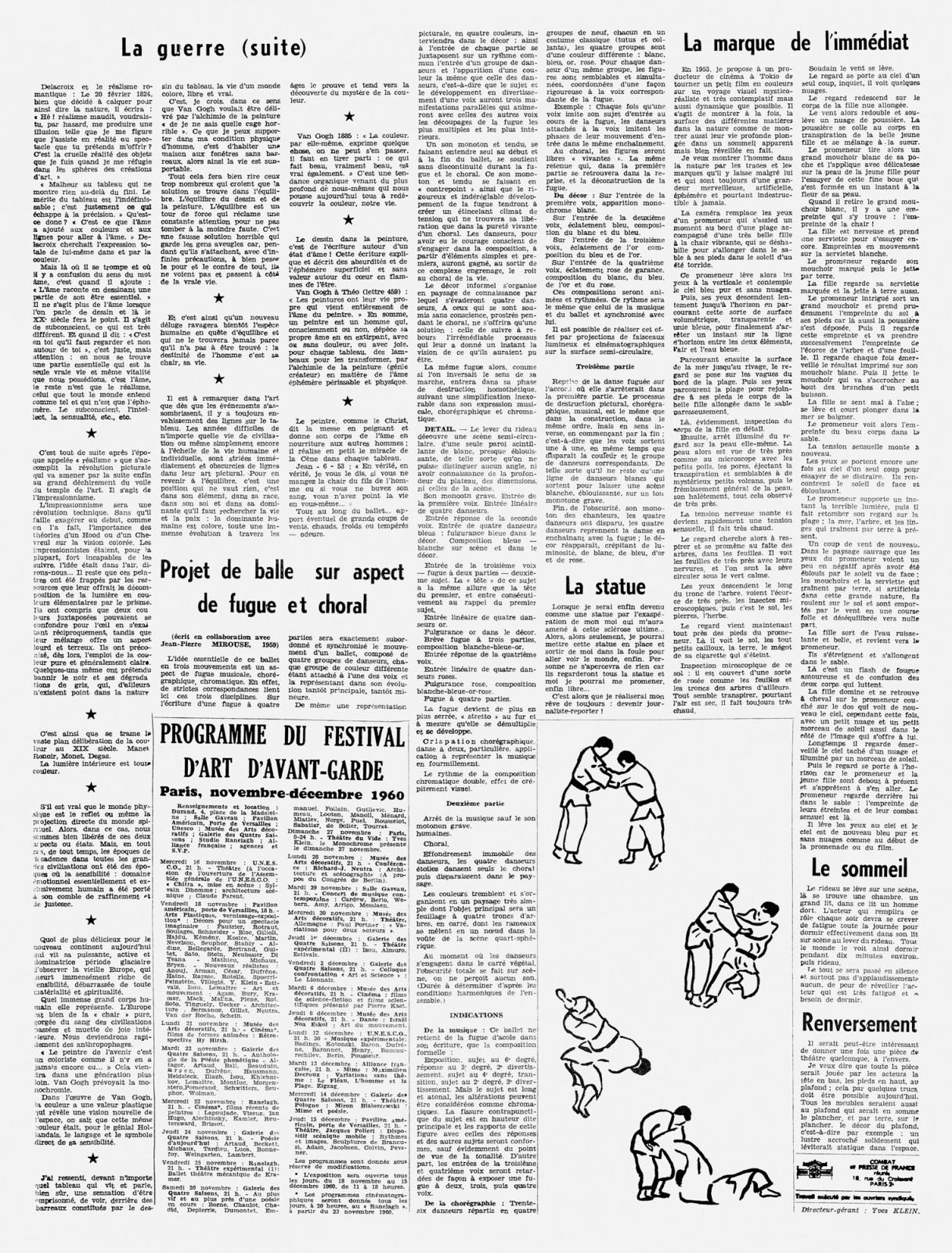
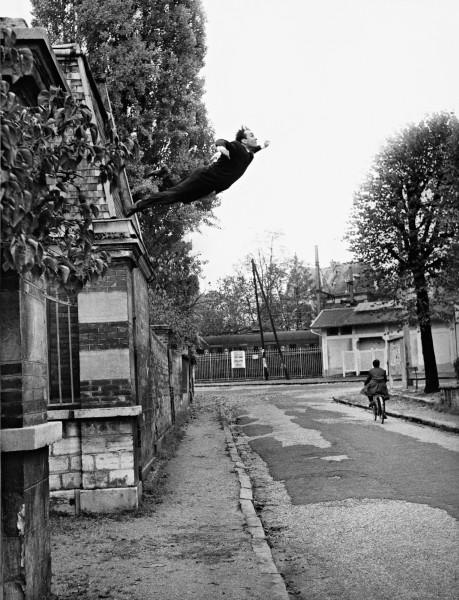
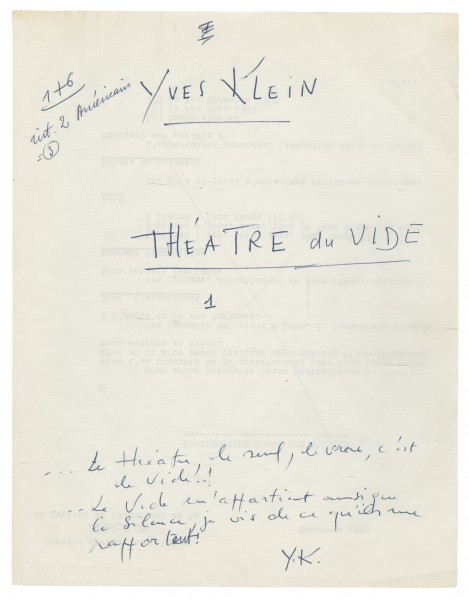
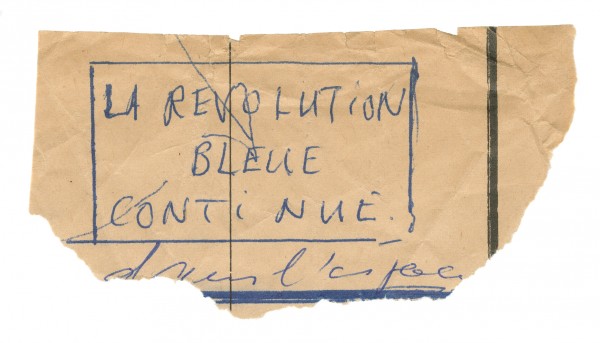
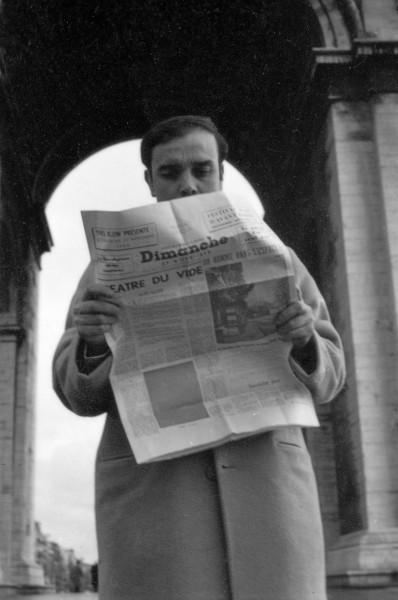
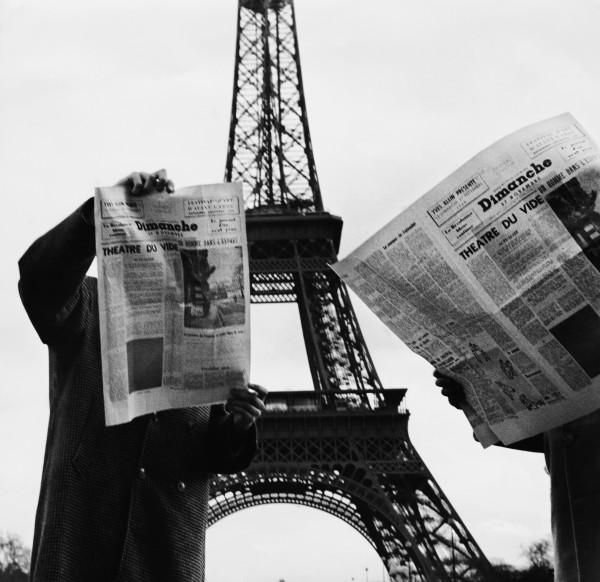
![Dimanche 27 novembre [Sunday, November 27th]](/files/film_thumbnail_80.jpg)
